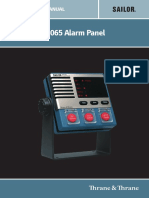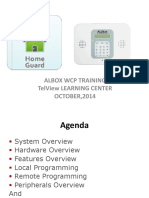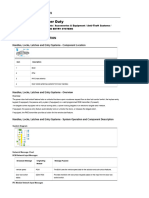Electrical System: Fiat Barchetta
Electrical System: Fiat Barchetta
Uploaded by
Hallex OliveiraCopyright:
Available Formats
Electrical System: Fiat Barchetta
Electrical System: Fiat Barchetta
Uploaded by
Hallex OliveiraOriginal Title
Copyright
Available Formats
Share this document
Did you find this document useful?
Is this content inappropriate?
Copyright:
Available Formats
Electrical System: Fiat Barchetta
Electrical System: Fiat Barchetta
Uploaded by
Hallex OliveiraCopyright:
Available Formats
Fiat barchetta Electrical system
'97range Radiofrequency
alarm
55.
INTRODUCTION
The V.A.S. (Vehicle Alarm System) radiofrequency alarm system offers volumetric and perimetral pro-
tection; it checks the status of the bonnet/boot/doors and whether there are moving objects in the inte-
rior compartment.
In particular, it can:
- adapt its operation to the regulations in force in various countries, concerning alarm systems;
- distinguish errors or intermittent or permanent faults;
- memorize the number of alarms carried out.
The alarm system basically consists of the following: radiofrequency receiver built into the courtesy
light, radiofrequency transmitter (remote control), hyperfrequency sensor for checking the seat and
pedal assembly areas, door/bonnet/boot switches, electronic control unit located in the engine com-
partment opposite the battery cage, which incorporates a self-supplied siren and emergency key switch
(ON - OFF) for deactivating/activating the system, also located on the electronic control unit.
NOTE Theradiofrequency remote control facilitates the activation and memorization operations,as,
comparedwith the infrared system,this systemhasa largerradius of action and is not direction-
at
ALARM CONTROL UNIT
This is the main unit of the system. It checks
and processes the status of the following
sensors:
- boot sensor;
- bonnet sensor;
- door open/closed sensors, on the locks;
- hyperfrequency sensor for checking the
pedal assembly and seat areas;
- ignition switch.
The electronic control unit also includes the
compact self-supplied siren.
The intensity of the siren's sound depends on
the country of registration of the car (see
"COUNTRY CODE PROGRAMMING").
NOTE The siren can be excluded by press-
ing the remote control button for
over 4 seconds on switching on the
alarm.
TRANSMITTER
The transmitter is the device which switches the alarm system on and off. It has a button and an LED: the
button activates the command, the LED permits a visual check that the transmitter is sending the code.
The transmitter is characterized by its small size, and impact-proof and water-tight casing. It also has an
adhesive plate with the 4-digit code corresponding to the transmitter's password engraved on it.
Copyright Fiat Auto 1
Electrical system Fiat barchetta
Radiofrequency alarm '97 range
RECEIVER
1. Green LED
2. Memorization button
Receiver connector
1. N.C.
2. Serial line to alarm control unit
3. Positive from battery (+30)
4. Earth
5. Door unlock
6. Door lock
7. Key-dependent positive (+15)
The receiver, built into the courtesy light, is
an electronic device which receives the sig-
nal coming from the remote control. It carries
J P3WO2ALO1 out the functions of controlling the open-
ing/closing of the doors, and the switching
on/off of the alarm control unit.
Every receiver may be programmed with one or several transmitters (up to a maximum of 8), memorizing
the relevant codes. On the receiver there is a green lED (1) which comes on when the signal is received,
while a special button (2) memorizes the code.
At the time of assembly onto the car, the receivers contain a so-called "UNIVERSAL" code used for car-
rying out the end-of-production line tests, with an appropriate transmitter with universal code. When
the car is delivered to the Customer, the receiver must be customized by replacing the "UNIVERSAL"
code with those of the transmitters supplied with the car (see "PROGRAMMING" on the next pages).
EMERGENCY KEY SWITCH
The key switch on the emergency circuit is
located on the alarm control unit in the en-
gine compartment. This enables the system
to be excluded if necessary.
Deactivation Turning the emergency key an-
ti-clockwise (OFF position)
Activation Turning the emergency key
clockwise (ON position)
INDICATOR/DISSUASION LED
The system indicator LED (red) is located on the central console between the digital clock and the ash-
tray; it indicates the status of the system and any faults (see description below).
HYPERFREQUENCY SENSOR FOR PROTECTING THE PEDAL ASSEMBLY AND SEAT AREAS
The sensor for protecting the pedal assembly and seat areas provides additional surveillance, checking
that there are no intrusions in the vehicle. It is located near the central console and it functions as both
transmitter and receiver.
2 Publication no. 506.586/07
Fiat barchetta Electrical system
'97 range Radiofrequency alarm
OPERATION
Switching on - off
The alarm is ACTIVATED by pressing the button on the transmitter (remote control) with the key re-
moved from the ignition switch; switching on is indicated by the direction indicators coming on for
about 2.5 seconds and a corresponding acoustic signal (beep). The range of action is about 10 metres.
It is DEACTIVATED by pressing the remote control button again: switching off is indicated by two flash-
es of the direction indicators and two corresponding acoustic signals (beeps).
The alarm can be switched on with the ignition key in the STOP or PARK positions.
Switching on is also indicated by the dissuasion LED and, only in countries whose legislation so per-
mits, by visual and acoustic signals, as stated previously for the "ITALY" operating mode.
Exclusion of the system
If the transmitter batteries are discharged or the alarm system is faulty, it can be deactivated by turning
the emergency key on the control unit to the OFF position (however, the remote door opening/closing
function will be maintained).
When the car is delivered, check that the emergency key on the control unit is in the ON position.
Turn the key to the OFF position if the car is to be left unused for a long period (over 3 weeks). To reset
the system, turn the emergency key to the ON position again.
Surveillance
During surveillance the dissuasion LED flashes at a frequency of 0.8 Hz.
In this state, the alarm system checks:
- the doors, bonnet and boot;
- when the battery has been disconnected/the cables cut;
- the ignition switch against unauthorized key insertions;
- intrusion into the interior compartment (hyperfrequency sensor).
Alarm status
The systemgoes into alarm when one of the sensorsassignedto surveillance(see preceding list) en-
counters.a faulty situation.
The alarm condition is shown by the activation of the siren and direction indicators for about 26 sec-
onds, for a maximumof three cyclesper input (only in countrieswhere the legislationso permits), if the
cause of the alarm persists.
To exit from the alarm situation:
- pressthe transmitter button;
- turn the emergencykey to the OFF position.
NOTE Inside the control unit, the alarm "on" condition is memorized for the "SUR VElLLANCE" stage.
NOTE Only use this procedure in emergencyconditions, if the alarm system cannot be switched off
with the remote control.
Inhibition of volumetric surveillance
There are two methods of inhibiting the protection of the pedal assembly and seats areas, before switch-
ing on the alarm system:
1. with the ignition on (MAR position), briefly (0.5 seconds) press the receiver button and then, within
a maximum of 8 seconds, turn the ignition off (STOP position).
Copyright Fiat AtJto 3
Electrical system Fiat barchetta
Radiofrequency alarm '97 range
2. Starting with the ignition on, quickly turn the key to the following positions: OFF - ON - OFF.
The exclusion of volumetric surveillance is confirmed by the dissuasion LED coming on for 2 seconds.
Theignition can be switched on for a maximumof 30 secondsafter the above-mentionedproce-
dure, without re-enabling volumetricsurveillance;this function is useful, for exampleto enable
the electric windows to be closed.
Volumetricsurveillance is re-enabled when the ignition is next switched on for a period of over 30 sec-
onds, and when the alarm is switched on again.
Alarm auto switch-on (Belgium and United Kingdom markets only)
Cars with alarm programmed for the Belgium and United Kingdom markets have the "passive auto
switch-on" function. This allows the automatic partial switching on of the alarm a short time (28 sec-
onds) after the car has been left by the user. Surveillance in "passive" operating mode is the same as in
the normal operating mode, activated by transmitter, but door closing does not take place. Automatic
switch-on is activated 28 seconds after the following conditions have arisen:
- ignition switched off (STOP position);
- opening and then subsequent closure of the last open door/bonnet/boot.
If any door, the bonnet or boot is opened before the time lag (28 seconds) elapses, counting is stopped.
Closure resets counting, which starts from zero.
To regain possession of the car after auto switch-on, the user should press the transmitter button
once.
Switching on the alarm with exclusion of siren
The operation of the siren can be excluded during switching on, by pressingthe transmitter button for
over4 seconds.After the acoustic/visualindicationsthat the alarmhasbeenswitched on, 5 beepsof the
siren follow in rapid successionto indicate that the siren has been excluded during surveillance.
Indication of transmitter batteries discharged
This indication may occur in two ways:
- by a single flash of the transmitter LED whenever the alarm switch-on button is pressed, instead of the
series of flashes under normal conditions;
- by the dashboard indicator LED coming on and staying on whenever the alarm system is switched off;
the LED goes out automatically after about two minutes or when the ignition is switched on.
If one of the above-mentionedindications occurs, the transmitter batterieshaveto be replaced.When
the batteriesare replaced,the LED on the transmitter resumesits normal flashing.
PROGRAMMING
The alarmindication methodsmayvary dependingon the laws in force in the country of registration;the
system must therefore be programmedby entering the country code as describedbelow.
The system "recognizes" the code of the remote controls with no limit as to quantity, but only the last 8
remain memorized (when the 9th remote control is entered, the first is deleted from memory).
There are 2 programming methods:
- before entering the password: SIMPLIFIED PROGRAMMING
- after entering the. password: PROTECTED PROGRAMMING
4 Publication no. 506.586/07
Fiat barchetta Electrical system
'97 range Radiofrequencyalarm
55.
In view of the importance of following the programming procedure in quick and precise se-
quence,it is advisableat least at first for two people to carry out the operations:one to read the
instructions in order, and the other to carry them out strictly.
Each transmitter has a plate with the password (4-digit code) for protection from unauthorized pro-
gramming (protected programming). The plates (one per transmitter) must be removed by the Customer
at the time of purchase, and put on the back of the CODE Card (refer to the Fiat CODE sub-section).
SIMPLIFIED PROGRAMMING
A transmittermust always be memo-
rized with:
- the alarm switched off with the re-
mote control (dissuasionLED)
- ignition key at STOP/PARK posi-
tion or removed
- emergencykey on control unit in
engine compartment at ON posi-
tion.
With this programming system, all the remote
control codes,with no limit asto quantity, are
"recognized", but only the last 8 remain
memorizedby the system as follows:
1. Press and hold down the button (5) on the
courtesy light (receiver); the adjacent LED
(4) must come on flashing;
2. Holding button (5) pressed down, press
the transmitter button (3);
3. Then release the button (3) when the cour-
tesy light LED (4) stays on permanently;
4. Then release the button (5) on the cour-
tesy light to complete the simplified pro-
gramming procedure.
5. If the flashing receiver LED goes out when
the remote control button is pressed, this
indicates that the receiver's memory is
closed; "PROTECTED" programming
must then be used.
NOTE To enter a subsequent remote con-
trol, repeat the operations from point
number 1. of simplified program-
ming.
1. transmitter LED
2. 4-digit password code plate
3. control button on transmitter
4. LED on courtesy light
5. Programming button
P3WO5ALO2
Copyright Fiat Auto 5
Electrical system Fiat barchetta
Radiofrequency alarm '97 range
55.
Country code programming
Procedure a)
After memorizing the remote controls as described on the preceding page, within 15 seconds of releas-
ing the receiver button on the courtesy light, the code of the country where the alarm system is to oper-
ate will have to be memorized.
The country code is programmed by pressing the receiver button n times in rapid succession (see table
below): at each press, the LED will flash.
If the button is not pressed, the sets itself to the country code memorized previously; if there is no coun-
try code memorized (1st programming), the system automatically sets itself to the "ITALY" operating
mode.
NOTE The 15 seconds are reduced to 3 from the second memorization onwards.
I(the procedurehas been carriedout correctly,the LED on the receiverwill flash n times (where
n is the selected country code number), confirming the memorizationof the code in both the
courtesylight receiverand the control unit: if not, the LED comeson and STAYSON for 5 sec-
onds and all the operationswill have to be repeatedstarting from point 1 of simplified program-
ming.
NOTE Toprogrammethe country code,it is preferableto use the procedurewith the diagnosticequip-
ment (for exampleFiat/Lancia Tester).
Procedure b)
Alternatively the country code can be programmed in accordance with the following procedure:
- open the bonnet;
- turn the ignition off (STOP position), then within 15 seconds press the bonnet button 7 times in rapid
succession in less than 10 seconds (bonnet open sensor); 5 beeps will indicate entry into MANUAL
DIAGNOSIS (see sub-section). During this stage (5 beeps) press and hold down the bonnet switch.
A final long beep will indicate acceptance of the latter action;
- hold down the switch throughout the duration of the long beep. This confirms entry into "country
code programming", and so the possibility of then entering the country code;
release the switch and within 10 secondspressthe sameswitch n times in accordancewith the table
above, to select the operating mode for the desired country (each press will have a confirmation
beep).
6 Publication no. 506.586/07
Fiat barchetta Electrical system
'97 range Radiofrequency alarm
CLOSING THE MEMORY
To avoid the unauthorized entry of remote controls, the memory must be protected (closed); this opera-
tion takes place automatically after the alarm system has been switched on/off 128 times. The memory
can also be closed manually by entering the "Password" (4-digit code stated on the transmitter plate),
for example before delivery of a new car, after all the codes of the remote controls given to the customer
have been entered.
To enter the Password, proceed as follows:
1. Pressthe receiver button for one second: the LED flashes for as long as the button is pressed.
2. Releasethe button: after about 3 seconds, the LED flashes briefly to indicate the request to enter the
first drgit of the password.
3. Pressthe receiver button as many times as indicated by the first digit of the Password (if for example
the Password is 5.2.0.3., press 5 times). Note that whenever the button is pressed, the LED comes on
brrefly to give visual confirmation (feed back).
4. About 3 seconds after the last press of the button (the fifth in the example), the LED emits another
flash to request entry of the next digit.
5. Proceed from point 3 to enter all the subsequent digits.
NOTE When the Password (see example) contains a "0", the button on the receivershould not be
pressed, instead wait for the next request to enter a digit, indicated by the subsequent flash.
After entering the 4 digits of the Password, the LED on the receiver may behave as follows:
- it flashes for about 10 seconds: this indicatesthat the Passwordhas beenenteredcorrectly;
- it comes on and stays on for about 10 seconds: this meansthat the Passwordhas not beenenteredcor-
rectly. In this case, after the LED goes out, the correct Password will haveto be re-enteredstarting from point 1.
The correct entry of the Password "closes" (protects) the memory, to prevent the memorization of unau-
thorized remote controls.
A new transmitter cannot be memorized with the memory "closed", as after transmitting the new code,
the LED on the receiver will stop flashing to indicate the failure of the operation. To memorize a new re-
mote control, the memory has to be "opened", in accordance with the following procedure.
PROTECTED PROGRAMMING
If the memory is "closed", further remote control codes can only be entered after "opening" the memory.
OPENING MEMORY AND MEMORIZATION OF A NEW REMOTE CONTROL
Opening the memory
The memory must be opened in accordance with the operations described below, carried out in rapid se-
quence:
1. press the button (5, next page) on the receiver for about 1 second; the LED (4) will flash for as long
as the button is pressed;
2. release the button; after about 3 seconds, the LED emits a brief flash which indicates that the first
digit of the Password can be entered;
3. press the receiver button (5) as many times as indicated by the first digit of the Password (if for ex-
ample the Password is 5.2.0.3., press 5 times). Note that whenever the button is pressed, the LED (4)
comes on briefly to give visual confirmation (feed back);
Copyright Fiat Auto 7
Electrical system Fiat barchetta
Radiofrequency alarm '97 range
55.
4. about 3 seconds after the last press of the
button (the fifth in the example), the LED
emits another flash to request the entry of
the next digit;
5. proceedfrom point 3 to enter all four dig-
its (if the digit is "0", do not pressthe but-
ton, instead wait for the next request);
6. if the Password is entered correctly (mem-
ory opened), the LED starts flashing (for
about 10 seconds); if instead it comes on
and stays on (for about 10 seconds), re-
peat the procedure from point 1.
Memorization of a new transmitter
7. While the LED (4) is flashing, press and
hold down the button (5); the LED (4)
will continue to flash;
8. press the button (3) of the new transmitter
until the green LED (4) on the courtesy
light stays on;
9. then release the transmitter button (3)
when the LED (4) on the courtesy light
stays on;
10. then release the button (5) on the cour-
tesy light to conclude the programming
procedure.
If the procedure has been carried out
correctly, the LED on the receiver will
flash n times (where n is the selected
country code number), confirming
that the code has been memorized
both in the receiver and in the control
unit; if not, the LED comes on and
STAYS ON for 5 seconds; all the op-
erations will then have to be repeated
from point 1 of the programming.
After memorizingthe new transmit-
ter, the memory returns to being
"closed".
8 Publication no. 506.586/07
Fiat barchetta Electrical system
'97range Radiofrequency alarm
55.
SYSTEM SELF-TEST
The alarm system can indicate any system faults to the user by the indicator LED on the central console
between digital clock and ashtray coming on and staying on or flashing.
When switched on the system carries out a self test the satisfactory result of which is indicated by the
flashing of the indicator LED at 4 Hz. If there is a fault in the system, the LED shows it in accordance
with the table below.
If a door, the bonnet or boot is open, the relevantsensoris excludedfrom surveillanceand an acoustic
signal (a further beep) is emitted 1 s after the entry beep.
When switched off, the system indicates by the flashing of the dissuasion LED which sensor during
surveillance activated an alarm that may have occurred (see table below).
Alarm indication
NUMBER OF FLASHESI IDENTIFICATION OF SENSOR(S) ENTERED INTO ALARM
~ Front riqht door
Front left door
~ Bonnet
Boot
8 + 1 5 key deoendent oositive
+30 direct supply or cuttinQ of cables of emergency remote key.
At least 3 causes of alarm I
*) Remote control battery discharged (*)
(*) Diagnosis indication
The flashesareemitted in sequence,at intervals of 1.5 s for a maximum of 2 minutes or until the ignition
is switched on.
If the dissuasion LED often indicates faults, the User should contact the Fiat Service Network. Remem-
ber that during Service interventions on a car or in the case of faults in the alarm which activate the siren,
the alarm system may be excluded by turning the emergency key switch, located on the alarm control
unit in the engine compartment, from the ON to the OFF position.
After completing the intervention, turn the emergency switch to the ON position and always refit
the protective cap on the switch.
Each individual component of the alarm systeminstalled in the car forms an integral part of it,
and so must not be fitted to or tested on other cars, even if of the same model.
Copyright Fiat Auto 9
Electrical system Fiat barchetta
RadiofreQuencyalarm '97 range
MANUAL DIAGNOSIS
" ..
Stage 1 (activation of manual diagnosis)
/ j ((t\. ,,-' Proceed as described below:
- Open the bonnet;
~/;~-~:-~~~~~~
- turn the ignition off (STOP position), then
~y~ within 15 seconds press 7 times in rapid
succession (in less than 10 seconds) the
"t ~- switch shown in the figure (bonnet open
sensor); 5 beeps will indicate the entry into
"MANUAL DIAGNOSIS"; after 10 seconds
the direction indicators will come on for
':~~;;;~~~~ about half a second.
P3W10ALO1
Stage 2 (manual diagnosis of volumetric sensor)
The "MANUAL DIAGNOSIS" mode automatically activates the procedure for self-testing the volumet-
ric sensor (during this stage keep the doors and windows closed):
- if there are no faults, the siren will emit 3 beeps and the direction indicators will flash 3 times;
- if there is a fault, one flash and one beep will be emitted.
Stage 3 (manual diagnosis of doors/bonnet/boot open/closed sensors)
Carry out diagnosis on each open/closed sensor of moving parts (doors/bonnet/boot):
whenever a door, the bonnet or the boot is opened, a beep of the siren is emitted, accompanied by a
brief flash of the direction indicators and the dissuasion LED.
Stage 4 (deactivation of manual diagnosis)
You can exit from "MANUAL DIAGNOSIS" in two ways:
- automatic: do not open a door, the bonnet or boot for at least 30 seconds;
- manual: turn the ignition key from STOP to MAR.
The exit from "MANUAL DIAGNOSIS" mode is indicated by a beep (0.5 s) and by the direction indica-
tors coming on (2.5 s).
FAULT DIAGNOSIS BY FIAT-LANCIA TESTER
The systemhasa specific diagnostic socketfor connecting to the FIAT/LANCIA Tester,or to other diag-
nostic instruments.
Before connecting the Tester,make sure that the key on the emergencyswitch is set to ON.
10 Publication no. 506.586/07
Fiat barchetta Electrical system
'97 range Radiofrequencyalarm
INPUT AND OUTPUT SIGNALS TO/FROM ALARM CONTROL UNIT
(*): The table gives all the input
and output signals to/from
the control unit. The pins
whose functions are marked
with an asteriskare not con-
nected.
Copyright Fiat Auto 11
Electrical system Fiat barchetta
Radiofrequency alarm '97 range
DIAGRAM OF CONTROL UNIT CONNECTIONS
P3W12ALO1
24. Fusebox 117. Door lock remote control receiver
31. Fuse and relay unit 121. Front right earth
48. Alarm electronic control unit 130. Diagnostic socket for alarm system
64. Alarm device switch on bonnet 132. Hyperfrequency sensor
107. Front left door lock 160. Boot open indicator button for an-
108. Front right door lock ti-theft device
162. Alarm system LED
12 Publication no. 506.586/07
Fiat barchetta Electrical system
'97 range Radiofrequency alarm
LOCATION ON CAR OF ALARM SYSTEM COMPONENTS
~\
\ '\
\
(1) ~\\
\ "" "\
\
I
/
\
\ "'"
\
\ ;'
\
\
..- ,/
)
'"
~y
~\ \
\
-;
\ ..."/
./
4\ '-;
'~ ""'.
---I
y
(fjJ"""'",,~---
--"" tV'
AX ;-
,~
;::;:-~ ~-v I:!
@
"'~,,==-
N°'
P3WO77l01
1. Bonnet open indicator button
2. Alarm control unit with siren and switch-off key
3. Hyperfrequency sensor for checking pedal assembly and seat areas (intrusion into car interior)
4. LED indicating anti-theft device on
5. Button indicating right door open
6. Receiver on courtesy light
7. Button indicating boot open
8. Button indicating left door open
Copyright Fiat Auto 13
You might also like
- Harley Davidson Sportster XLH 883 & XLH 1200 (1993-1994) Service and Repair Manual (Part2)83% (6)Harley Davidson Sportster XLH 883 & XLH 1200 (1993-1994) Service and Repair Manual (Part2)130 pages
- Clipsal Burglar Alarm System - 5400 & 5400/16CBNo ratings yetClipsal Burglar Alarm System - 5400 & 5400/16CB30 pages
- FM4000E - CI-146 Iss3 FM4000E InstallationNo ratings yetFM4000E - CI-146 Iss3 FM4000E Installation15 pages
- Keyless Entry System: Wiring Diagram of The Main UnitNo ratings yetKeyless Entry System: Wiring Diagram of The Main Unit1 page
- Cobra Electronics 8185 Instruction Manual 221137No ratings yetCobra Electronics 8185 Instruction Manual 2211376 pages
- SAILOR AP5065 Alarm Panel: Installation ManualNo ratings yetSAILOR AP5065 Alarm Panel: Installation Manual24 pages
- 4098-9714 - Detector de Humo Simplex DireccionableNo ratings yet4098-9714 - Detector de Humo Simplex Direccionable4 pages
- Handles, Locks, Latches and Entry SystemsNo ratings yetHandles, Locks, Latches and Entry Systems98 pages
- User Manual 4615 4625 4627 4685 4693 4698 1No ratings yetUser Manual 4615 4625 4627 4685 4693 4698 116 pages
- Wallace and Tiernan® Analytical Instrumentation: Acutec 35 Gas Detection SystemNo ratings yetWallace and Tiernan® Analytical Instrumentation: Acutec 35 Gas Detection System4 pages
- Fa1-V2 Fire Alarm Control Module: SystemsNo ratings yetFa1-V2 Fire Alarm Control Module: Systems2 pages
- Scanmax Hs Pro Antenna: (Inside NCR Scanner/Scale)No ratings yetScanmax Hs Pro Antenna: (Inside NCR Scanner/Scale)4 pages
- 635adac789d011138d8625fd - Q 1 61 November 2018 Trouble ShootingNo ratings yet635adac789d011138d8625fd - Q 1 61 November 2018 Trouble Shooting10 pages
- Install The Batteries Into The Remote(s) Before Doing So For The ReceiverNo ratings yetInstall The Batteries Into The Remote(s) Before Doing So For The Receiver2 pages
- Delco Manuals: Radio Model 633, Delcotron Generator Delco Radio Owner's Manual Model 633, Delcotron Generator InstallationFrom EverandDelco Manuals: Radio Model 633, Delcotron Generator Delco Radio Owner's Manual Model 633, Delcotron Generator InstallationNo ratings yet
- Building a High-Tech Alarm System with Raspberry Pi (Second Edition)From EverandBuilding a High-Tech Alarm System with Raspberry Pi (Second Edition)No ratings yet
- L6-GeoSpatial Technologies and Web Applications-Mr - Arulraj - NRSCNo ratings yetL6-GeoSpatial Technologies and Web Applications-Mr - Arulraj - NRSC52 pages
- Assignment: Ce Marketing Research & Data AnalyticsNo ratings yetAssignment: Ce Marketing Research & Data Analytics7 pages
- Lesson 1. Introduction To Statistics: OutlineNo ratings yetLesson 1. Introduction To Statistics: Outline18 pages
- User Prototype Test: Share A Quick & Dirty Mock-Up of The Concept With Users/Experts - To Fail and ImproveNo ratings yetUser Prototype Test: Share A Quick & Dirty Mock-Up of The Concept With Users/Experts - To Fail and Improve3 pages
- Model Displayable: Class Model (Size None, Properties)No ratings yetModel Displayable: Class Model (Size None, Properties)5 pages
- (DAILY CALLER OBTAINED) - EXCLUSIVE: Jim Jordan, Judiciary Republicans Reintroduce Bill That Would Kill Section 230No ratings yet(DAILY CALLER OBTAINED) - EXCLUSIVE: Jim Jordan, Judiciary Republicans Reintroduce Bill That Would Kill Section 2303 pages
- About GBPIET Computer Science & Engineering DepartmentNo ratings yetAbout GBPIET Computer Science & Engineering Department2 pages
- DRV832x 6 To 60-V Three-Phase Smart Gate Driver Datasheet (Rev. D)No ratings yetDRV832x 6 To 60-V Three-Phase Smart Gate Driver Datasheet (Rev. D)1 page
- GSM - Jamming - Detection - Application - Note 3.0 - 2No ratings yetGSM - Jamming - Detection - Application - Note 3.0 - 217 pages
- Harley Davidson Sportster XLH 883 & XLH 1200 (1993-1994) Service and Repair Manual (Part2)Harley Davidson Sportster XLH 883 & XLH 1200 (1993-1994) Service and Repair Manual (Part2)
- Keyless Entry System: Wiring Diagram of The Main UnitKeyless Entry System: Wiring Diagram of The Main Unit
- 4098-9714 - Detector de Humo Simplex Direccionable4098-9714 - Detector de Humo Simplex Direccionable
- Wallace and Tiernan® Analytical Instrumentation: Acutec 35 Gas Detection SystemWallace and Tiernan® Analytical Instrumentation: Acutec 35 Gas Detection System
- Scanmax Hs Pro Antenna: (Inside NCR Scanner/Scale)Scanmax Hs Pro Antenna: (Inside NCR Scanner/Scale)
- 635adac789d011138d8625fd - Q 1 61 November 2018 Trouble Shooting635adac789d011138d8625fd - Q 1 61 November 2018 Trouble Shooting
- Install The Batteries Into The Remote(s) Before Doing So For The ReceiverInstall The Batteries Into The Remote(s) Before Doing So For The Receiver
- Delco Manuals: Radio Model 633, Delcotron Generator Delco Radio Owner's Manual Model 633, Delcotron Generator InstallationFrom EverandDelco Manuals: Radio Model 633, Delcotron Generator Delco Radio Owner's Manual Model 633, Delcotron Generator Installation
- Building a High-Tech Alarm System with Raspberry Pi (Second Edition)From EverandBuilding a High-Tech Alarm System with Raspberry Pi (Second Edition)
- L6-GeoSpatial Technologies and Web Applications-Mr - Arulraj - NRSCL6-GeoSpatial Technologies and Web Applications-Mr - Arulraj - NRSC
- Assignment: Ce Marketing Research & Data AnalyticsAssignment: Ce Marketing Research & Data Analytics
- User Prototype Test: Share A Quick & Dirty Mock-Up of The Concept With Users/Experts - To Fail and ImproveUser Prototype Test: Share A Quick & Dirty Mock-Up of The Concept With Users/Experts - To Fail and Improve
- Model Displayable: Class Model (Size None, Properties)Model Displayable: Class Model (Size None, Properties)
- (DAILY CALLER OBTAINED) - EXCLUSIVE: Jim Jordan, Judiciary Republicans Reintroduce Bill That Would Kill Section 230(DAILY CALLER OBTAINED) - EXCLUSIVE: Jim Jordan, Judiciary Republicans Reintroduce Bill That Would Kill Section 230
- About GBPIET Computer Science & Engineering DepartmentAbout GBPIET Computer Science & Engineering Department
- DRV832x 6 To 60-V Three-Phase Smart Gate Driver Datasheet (Rev. D)DRV832x 6 To 60-V Three-Phase Smart Gate Driver Datasheet (Rev. D)
- GSM - Jamming - Detection - Application - Note 3.0 - 2GSM - Jamming - Detection - Application - Note 3.0 - 2






























































































